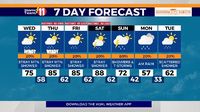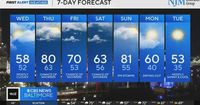As spring unfolds across the United States, weather patterns are shifting significantly, leading to warmer temperatures and changes in natural gas demand. Maryland is experiencing mild temperatures, and forecasts indicate a warm stretch ahead, coinciding with a decline in heating demand for natural gas.
On April 1, 2025, May Nymex natural gas (NGK25) closed down by 0.168, or 4.08%, reflecting the market's response to updated weather forecasts. According to NatGasWeather.com, these forecasts have shifted towards above-normal temperatures in the western, central, and southern United States for the period of April 6-13, 2025. This trend is expected to reduce heating demand for natural gas, which has been a significant factor in the market.
Last month, natural gas prices rallied to a two-year high due to indications that U.S. natural gas storage levels could remain tight ahead of the summer air-conditioning season. However, BloombergNEF projects that U.S. gas storage will be 10% below the five-year average this summer, which could have long-term implications for pricing and availability.
On April 1, Lower-48 state dry gas production was reported at 103.7 billion cubic feet per day (bcf/day), marking a 1.8% increase year-over-year. Meanwhile, gas demand in the same region was 77.5 bcf/day, a modest rise of 0.6% year-over-year. These figures highlight a slight uptick in consumption, despite the overall warmer weather forecast.
In terms of liquefied natural gas (LNG) exports, net flows to U.S. LNG export terminals on April 1 were 14.7 bcf/day, which is a decrease of 5.3% week-over-week. This drop could be attributed to the anticipated changes in domestic demand as warmer weather sets in.
Interestingly, the U.S. electricity output has also seen a positive shift. The Edison Electric Institute reported that total U.S. electricity output for the week ending March 22 rose by 0.9% year-over-year to 72,289 gigawatt hours (GWh). Over the past year, U.S. electricity output has increased by 3.55% to 4,239,323 GWh, suggesting that while gas heating demand may decrease, electricity needs are on the rise.
In a notable political development, President Trump lifted the Biden administration's pause on approving gas export projects in January, moving forward with a backlog of approximately a dozen LNG export projects. This decision is expected to boost demand for U.S. natural gas and support prices in the longer term.
Despite these optimistic signs, the latest weekly EIA report presented a bearish outlook for natural gas prices. For the week ending March 21, natural gas inventories rose by 37 bcf, surpassing expectations of a 33 bcf increase and well above the five-year average draw for this time of year, which typically sees a -31 bcf draw. As of March 21, natural gas inventories were down 24% year-over-year and 6.5% below their five-year seasonal average, indicating tight supplies.
Across the Atlantic, Europe is also facing challenges, with gas storage reported at 34% full as of March 30, compared to the five-year seasonal average of 45%. This gap highlights the ongoing energy supply concerns in the region.
In the drilling sector, Baker Hughes reported that the number of active U.S. natural gas drilling rigs rose by one to 103 rigs in the week ending March 28. This figure is modestly above the three-and-a-half-year low of 94 rigs recorded on September 6, 2024. However, active rigs have significantly decreased from a five-and-a-half-year high of 166 rigs in September 2022, a stark contrast to the pandemic-era record low of 68 rigs in July 2020.
As for the weather, forecasts for Maryland indicate partly cloudy skies tonight with a low of 46 degrees. Wednesday, April 2, 2025, is expected to be partly cloudy, windy, and warm, with a high of 75 degrees. Winds will come from the southeast at 10 to 20 mph, with gusts reaching up to 30 mph.
Looking ahead, strong to severe thunderstorms are forecasted across the Ohio Valley extending southward to the Tennessee Valley and further south on Wednesday and Thursday. While some pop-up thunderstorms may occur, most of the active weather is expected to remain west, with heavy rainfall potentially causing flooding in those areas.
Thursday, April 3, 2025, will see continued warm temperatures, with a high of 85 degrees, which could break the previous record of 82 degrees set in 2012. The day will be partly cloudy and windy, with a 20% chance of a pop-up shower or thunderstorm. Thursday night is expected to be partly cloudy, with a low of 62 degrees.
Friday, April 4, 2025, will maintain the warm trend, with a high of 86 degrees and a 20% chance of a stray shower or thunderstorm. The record high for Friday was 83 degrees, set in 2023. The forecast for Friday night includes a low of 62 degrees and a 20% chance of scattered showers.
Saturday, April 5, 2025, is projected to be partly cloudy with a high of 88 degrees, surpassing the previous record of 86 degrees set in 2023. Clouds will increase overnight, leading to scattered showers and a low of 62 degrees.
Sunday, April 6, 2025, will bring cloudy conditions with an 80% chance of showers and thunderstorms, and a high of 72 degrees. As the weekend wraps up, Monday, April 7, 2025, is expected to have sunny skies and much cooler air, with a high of 57 degrees. Partly cloudy skies are forecast for Monday night, with a low of 33 degrees. Tuesday, April 8, 2025, will see a high of 62 degrees with a 20% chance of rain.
In summary, as the weather warms and natural gas demand fluctuates, the energy market is poised for changes that could affect consumers and industries alike. With increased temperatures and evolving energy policies, stakeholders will need to stay alert to the shifting landscape of natural gas and electricity supply.





